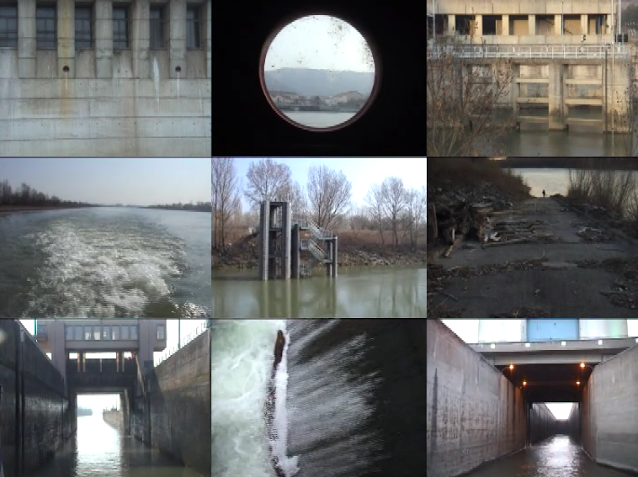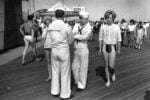Sic Vos Non Vobis

I lavori esposti disegnano una sorta di cartografia dell’acqua, il bene comune per antonomasia. Ma le opere indagano l’elemento da un punto di vista narrativo e cognitivo, al di là dell’immagine più immediata che la vedrebbe “contenuta” o “raccolta” nella forma di una fontana.
Comunicato stampa
Giovedì 13 marzo, alle ore 18.30, nell’ambito del programma artistico 2014 Commons Art, inaugura Sic Vos Non Vobis, mostra collettiva curata da Claudio Cravero.
Il titolo dell’esposizione riprende un aneddoto latino nel quale Virgilio, di fronte al plagio di una sua opera, avrebbe risposto dicendo “Sic Vos Non Vobis” (Per voi ma non vostra). Si tratta di una frase che, in seguito e in altri contesti, è possibile trovare incisa su alcune fontane pubbliche di diverse città italiane. Nell’esposizione Sic Vos Non Vobis diventa così una sorta di “statement” a ricordare quanto le acque scorrano naturalmente per loro stesse e a beneficio anche dei cittadini, pur essendo di proprietà di nessuno.
I lavori esposti disegnano una sorta di cartografia dell’acqua, il bene comune per antonomasia. Ma le opere indagano l’elemento da un punto di vista narrativo e cognitivo, al di là dell’immagine più immediata che la vedrebbe “contenuta” o “raccolta” nella forma di una fontana. I video, le installazioni, i disegni e documentazioni storiche (tra queste il documentario del 1949 prodotto dalla Compagnie Nationale du Rhône sulla costruzione della diga di Génissiat), mettono in evidenza quel gioco di tensioni tipico del potere e della volontà di controllo; le stesse forze che, tese tra loro, vedono l’acqua in bilico tra l’essere considerata un bene pubblico intoccabile e la sua privatizzazione a pura merce di profitto.
All’ingresso del PAV è allestita Robinet, installazione di Géraldine Py e Roberto Verde (1986, Francia; 1981, Italia). Da una sorta di rubinetto fuoriescono delle gocce d’acqua che bloccano il possibile volo di un palloncino gonfiato a elio. Nell’opera si palesano in modo tangibile gli sforzi spesso necessari per contrastare conflitti e tensioni, come quelli che investono l’acqua descritti da Shiva Vandana in Le Guerre dell’acqua. Nella serra è esposta inoltre la serie di acquerelli Aquifers di Marie Velardi (1977, Ginevra). Lo studio e la ricognizione di 37 falde acquifere in diverse parti del mondo rileva la precarietà di determinati territori e mette in luce come lo sfruttamento delle acque sotterranee sia strettamente collegato all’elemento “tempo”. Sempre nella serra, come due superfici specchianti, è esposta Cracks I Seldom Reveal, la doppia proiezione video di Amit Mahanti e Ruchika Negi (1978, Shillong; 1979, Bangalore) del collettivo indiano Frame Works. La loro ricerca esplora la cosiddetta “Ecologia umana” intorno ai temi dell’acqua. Riflettendo su una geografia allargata e mettendo a confronto due precisi territori (Torino e lo stato del Sikkim nei pressi dell’Himalaya), Frame Works ragiona sulla dicotomia “accesso” ed “eccesso” delle fonti idriche, restituendo un’immagine speculare delle due aree.
Nella project room, infine, è esposta Céromancie: sept questions au fleuve Rhône, di Andrea Caretto | Raffaella Spagna (1970, Torino; 1967, Rivoli). Nell’installazione, formata da sette oggetti in paraffina esposti su un tavolo luminoso, i due artisti presentano il risultato di uno studio svolto durante una residenza presso Moly-Sabata (F), nel 2011, lungo il tratto del Rodano tra Valence e Lione. Le sette sculture in cera costituiscono le risposte alle domande poste al fiume secondo la pratica tradizionale e divinatoria della ceromanzia. La volontà di controllo e l’esercizio del potere umano sul corso del fiume sono inoltre ben riassunti in Le contrôle des cinq écluses, video che testimonia l’attraversamento dei due artisti nel territorio rodaniano e che - sul modello delle telecamere a circuito chiuso - riporta la totale supervisione delle chiuse del fiume.
Nell’ambito della mostra, le Attività Educative e Formative del PAV, curate da Orietta Brombin, presentano dinamicoEstatico, laboratorio che osserva l’aspetto dell’acqua in superficie e nel suo incessante fluire. Sul piano della formazione per il pubblico adulto, dopo l’avvio della stagione 2014 dedicata alla Commons Art con Acqua che scorre non porta veleno, giornata condotta da Joe Quercia che grazie al role-playing ha affrontato il significato interiore dell’acqua, segue il 14 e 15 marzo il workshop condotto da Géraldine Py & Roberto Verde: I Vasi comunicanti. Tale fenomeno è fisico oltre che biologico ed economico e assume una forma globale, rappresentativa del principio olistico dove “Il tutto è maggiore della somma delle sue parti”. Tale modello è basato sulla solidarietà, lo scambio e l’equanimità, funzioni vitali che si manifestano già a livello cellulare nell’organismo vivente. Il progetto di costruzione collettiva vedrà la realizzazione di una rete di contenitori comunicanti - ottenuti con materiali di riciclo - il cui intento teorico è quello di dare spunto a conversazioni intorno all’economia di scambio, distribuzione di beni e capitali, metodi di sviluppo alternativi al mercato globale.
The group exhibition Sic Vos Non Vobis, curated by Claudio Cravero, will open on Thursday March, 13th at 6pm, in the context of the 2014 art program Commons Art.
The Latin title of the exhibition recalls a historical anecdote in which Virgil, after the plagiarism of one of his works, answered declaring: "Sic vos non vobis" ("For you but not yours"). At any rate, in other frameworks, this very maxim was subsequently engraved on many public fountains in some Italian town. Therefore, in the exhibition, "Sic vos non vobis" becomes a sort of statement that helps us to remember that waters flow naturally for themselves and also for the benefit of citizenship, as being owned by anybody.
The exhibited artworks outline a particular kind of cartography of water, the common good par excellence. Nevertheless, the works explore the object 'water' under a narrative and cognitive perspective, moving beyond the usual image of water being 'contained' and 'collected' in the shape of a fountain. Videos, installations, drawings and an historical document (a documentary of the 1950s directed by André Gillet and produced by the National Company of the Rhone river that is about the realisation of the Génissiat Dam) emphasise the game of tensions that are typical of power and the will of control. Hence these very tensions contrast each other and keep water in precarious balance between its being the foremost common good and its being privatised as a mere profitable commodity.
At the PAV entrance there is Robinet, an installation by Géraldine Py and Roberto Verde (1986, France; 1981, Italy). In this work water drops fall down from a particular kind of faucet, blocking the potential flight of a helium-filled balloon. Here it is possible to notice the efforts that more often than not are essential in order to avoid conflicts and tensions, such as the ones concerning water, which are described by Vandana Shiva in Water Wars (2002). In the PAV hall greenhouse it is also possible to find Aquifers, a watercolour series by Marie Velardi (1977, Geneva). The analysis and the mapping of 37 aquifers in different parts of the world show the precariousness of many areas and demonstrate how the exploitation of underground waters is deeply linked to the time factor.
Also in the PAV hall greenhouse, resembling two mirroring surfaces, is Cracks I seldom reveal, a double video projection by Amit Mahanti (1978, Shillong) and Ruchika Negi (1979, Bangalore) of the Indian Frame Works collective. Their research explores the so-called 'Human Ecology' in relation to the politics of water. Reflecting on an extended geography and comparing two specific territories (the Italian city of Turin and the Indian state of Sikkim, which is close to the Himalaya), they reflect upon the dichotomy between the access to and the excess of hydric sources, engendering a specular image of the two areas.
In the end, in the Project Room is Céromancie: sept questions au fleuve Rhône, by Andrea Caretto | Raffaella Spagna (1970, Torino; 1967, Rivoli). The installation consists of seven different objects made of paraffin that are displayed on a light table. The work is the result of a research that has been conducted in 2011 by the two artists during their artist-in-residence program at Moly-Sabata (F), alongside the Rhone River between Valence and Lyon. Following the traditional and soothsaying practice of wax telling, the seven wax sculptures represent the answers to the questions raised by the river itself. The will of control and the exercise of human power occurring alongside the river are expressed in the video Le contrôle des cinq écluses, which describes the voyage of the two artists in the Rhone area and - on the model of closed-circuit surveillance cameras - recounts the full-scale monitoring of the river dams.
In the context of the exhibition, the PAV Educational and Training Activities, curated by Orietta Brombin, presents staticoedinamico (static&dynamic), a workshop the purpose of which is to analyse the aspect of surface water and its neverending flow. For what concerns the training for adult audiences, the 2014 program opened with Acqua che scorre non porta veleno (Water that flows does not bring poison), a one-day workshop conducted by Joe Quercia that dealt with the inner sense of water by focusing on role-playing. Following this, the workshop I vasi comunicanti (The Communicating Vases), led by Géraldine Py & Roberto Verde, is scheduled on March 14th and 15th. The principle of communicating vases is physical as well as biological and economic. Moreover, it acquires a global dimension typical of the holistic maxim that “the whole is greater than the sum of its parts”. This model is based on solidarity, sharing and equanimity, which are the very vital processes that occur firstly at the cellular level in living organisms. The project of collective elaboration will foster the realisation of a web of communicating vessels – made of recycling materials – the theoretical purpose of which is to stimulate dialogues about exchange economy, the capital goods distribution system, and development strategies that are alternative to the global market.



